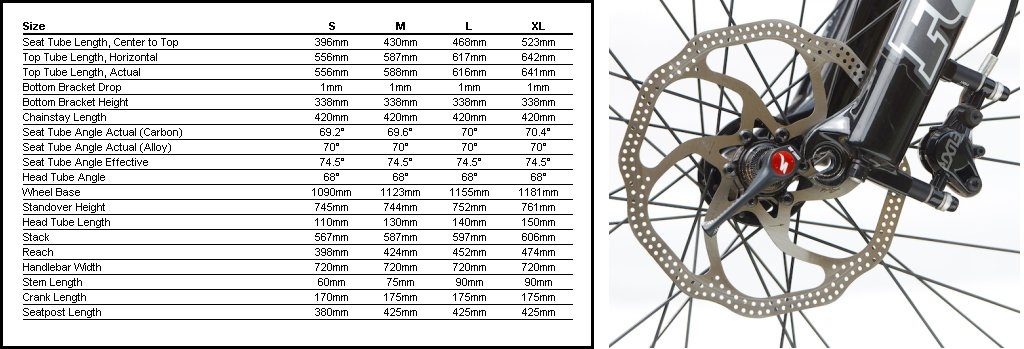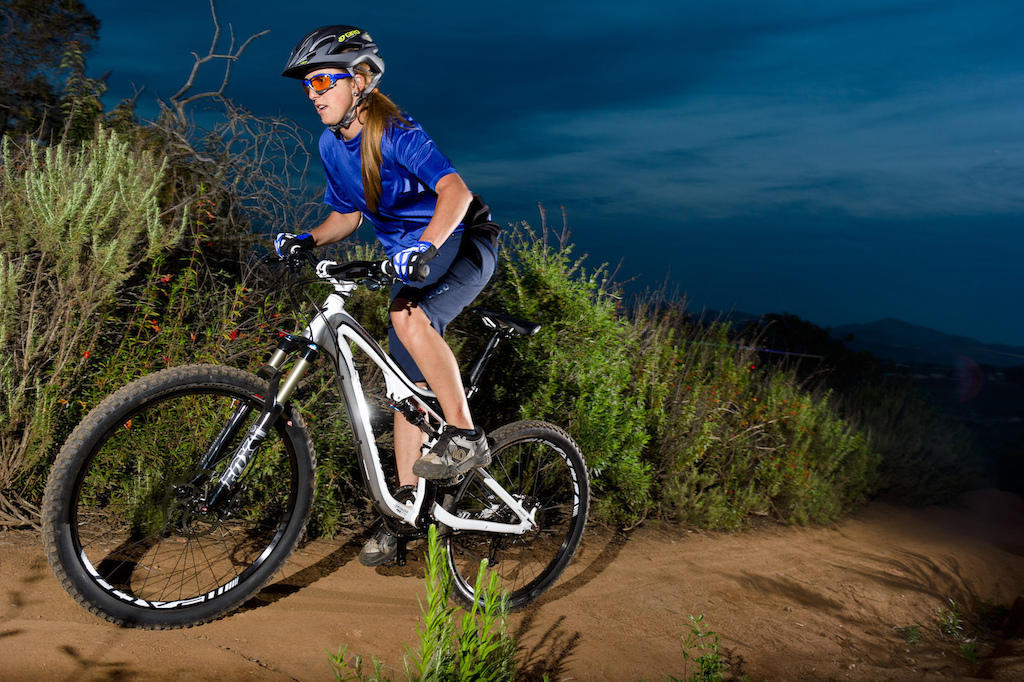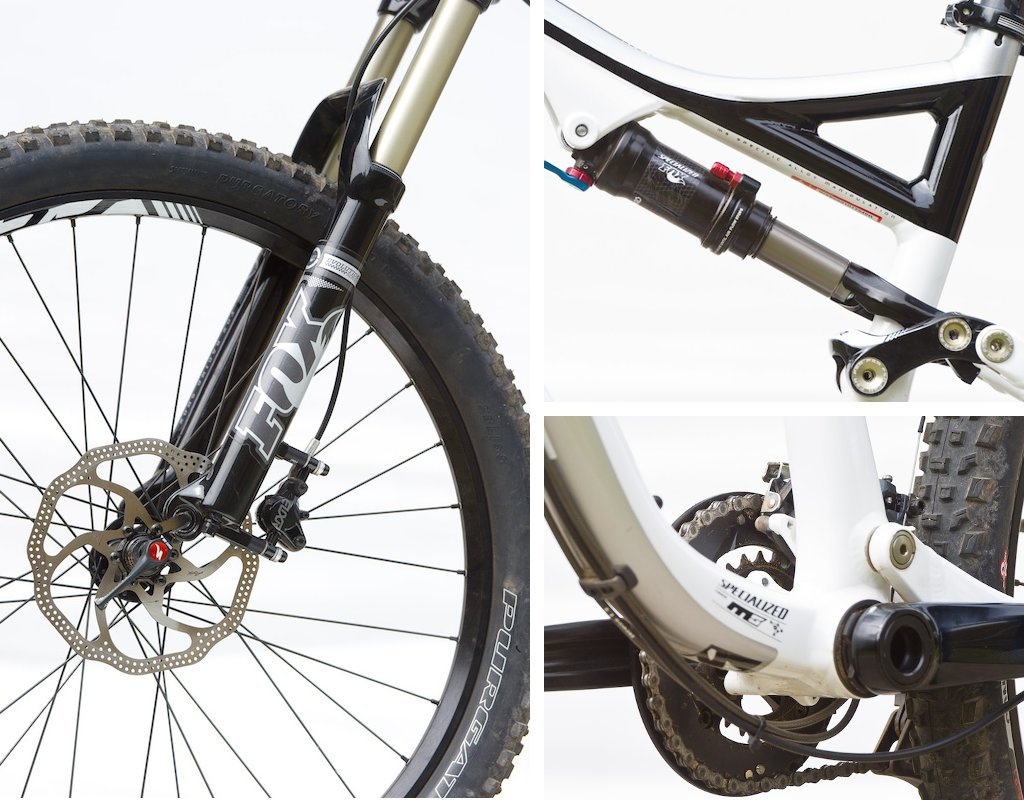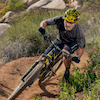Specialized Stumpjumper FSR Comp Review
TESTED
SPECIALIZED
STUMPJUMPER
FSR COMP
STUMPJUMPER
FSR COMP
BY Richard Cunningham
Specialized honed its FSR rear suspension and aluminum frame technology to near perfection on the Stumpjumper series, and the $2750 FSR Comp benefits hugely from a raincloud of innovations and improvements developed for upper-level Stumpies. Its component spec is decidedly XC/Trail, with a sweet SRAM two-by-ten drivetrain, a fast-rolling tire combination, a Fox Evolution F140 RL fork and made-for-Specialized Float Fox Triad II shock. Its handlebar is wide and the frame geometry is slack enough to qualify as a ‘modern trailbike design’ without giving up the desirable quickness of an XC bike. The beautifully crafted frame has plenty of stand-over clearance for technical riding, ISCG chainguide mounts in case you want to run a single ring later, a 142/12 through-axle, and plenty of room for tires up to 2.4 inches. In short, the 140-millimeter-travel FSR Comp inherits indelible Stumpjumper trailbike genetics, but its creators added gravity features to ensure that it could hold its own if it got into a tussle with a pack of muscular all-mountain bikes.
Ian Hylands photo
Construction Notes
Surprisingly well executed for a mid-priced model, the Stumpjumper Comp’s aluminum frame is painted with the quality and detail one may expect on a custom bike. Each main frame tube is manipulated in some way. The forked top tube has a tapered organic shape, while the seat tube morphs from round to square as it curves forward to support the upper suspension linkage. Look closely and you might notice the internal cable routing for a dropper post (RockShox Reverb or Specialized Command Post). Not so creative is its beefy downtube that copies the ubiquitous Northwest ‘hockey stick’ bend. A look at the bottom bracket area reveals a sturdy ISCG-05 chainguide flange and Specialized’s version of BB 30 – an oversized bottom bracket axle and matching press-in bearings that, in this case, house a non-series Truvative crankset.
Specialized Stumpjumper FSR Comp Geometry
Most of the Comp’s fireworks go off in the rear of the chassis, where the front derailleur operates on an extension of the swingarm so its geometry remains in line with the chain as the suspension cycles. The swingarm features internal routing for the rear derailleur housing, a 142/12mm through-axle and a trick-looking Moto-inspired XC chain guide that is molded into a beefy plastic chainstay protector. All the rear pivot points are clevises, which are the optimum design for those locations, and the shock is mounted on a yoke that keeps the upper rocker link short and stiff while controlling undesirable rate changes. As a side note, the non-standard shock might cause problems if you desire an upgrade later, or if Specialized moves on to yet another ‘proprietary’ shock design and leaves its previous customers short on spares (Just sayin’).
Component Check
Mid-priced performance bikes are by nature, a series of intelligent compromises, and Specialized is one of the best at the game. The use of in-house components helps maintain important features like a wide handlebar, lightweight wheels (Roval Control Trail rims), a comfortable saddle (Body Geometry Henge) and high-performance rubber (folding-bead Ground Control 2.1 rear and Purgatory 2.2 front) while saving up some cash to purchase brand-name items like its Fox Float RLC fork. Brakes are Avid Elixir 7 (Rotors: 160mm R /180m F), which feature a handy reach adjuster under the lever blades and integrated shift-lever mounts. The drivetrain is a mix and match, with a high-profile X.9 mid-cage rear derailleur, an X.7 front changer, powered by X.7 shifters. The non-series two-ring Truvativ crankset is actually an upgrade, as it has a bash ring and perfect-for-trail-riding, 38 x 24-tooth gearing, matched up with SRAM’s PG 1030 ten-speed 11 x 36 cassette.
Missing is a dropper seatpost which, it could be argued, would push the Comp well out of its under $3000 price point. That said; Specialized produces its own dropper post and thus, has the economy of scale to make it appear at lower price levels - providing that it puts its brain trust to the task. Get on it guys!
Stumpjumper Comp Trail Test
With 140 millimeters of suspension travel and 26-inch wheels, the Stumpumper FSR Comp is on the razor’s edge of being eaten alive by the popularity of 100 and 120-millimeter 29ers. The Stumpjumper Comp rides and feels a lot more like a cross-country trailbike than an aggressive all-mountain ride puts it squarely in the path of the big wheel bike. To stay ahead of the 29er, the Comp, it must to be lighter, more nimble and its suspension must be able to handle bigger jumps and drops.
For the most part, the FSR Comp flies the 26-inch flag proudly. Its extra measure of suspension travel is a big plus, with a cushy feel landing to flat and handling G-outs and it punches through bumps like reasonably sized logs and rocks with a firm, controllable feel. Its wheels and tires stay on line when pushed hard around corners and there is a sense of solidarity between the wheels, suspension and frame when the bike is ridden near its limits. The smallish 2.2-inch Purgatory Control (F) and 2.1 inch Ground Control (R) tires are tacky in the turns and roll quite fast on the harder sections of the trail, but they miss the mark over rough terrain, bouncing and skipping where a 29er shod with similar-width rubber would maintain composure.
Pedaling/Acceleration: At just under 28 pounds, the medium-sized FSR Comp is one of the lightest bikes in the $3000 trailbike category. Add its fast-rolling Purgatory Control and Ground-Control tires and firm-under-pedaling rear suspension and the Comp gets moving in a hurry. While it lacks some of the snap of an XC racer, the FSR Comp maintains momentum, rolling easily up and over small rises and reaccelerating out of slow corners with a few swift pedal strokes.
Climbing: With a slightly slack, 68-degree head angle the FSR Comp’s front end stays put and steers straight. Its compact, 429mm (16.5”) chainstays and full-time suspension action keeps the rear tire biting, so the ‘Comp is also an easy climber. Its 2.1 inch rear tire, however cannot deliver grip to match the technical ascending potential of the Stumpjumper chassis and it often spins the rear wheel at the crux of a climb. Wider rubber in the rear would be welcome. Specialized chose beautifully low 2 by 10 gearing (24 x 38 up front and 11 x 36 rear) with excellent spacing across the range, so little speed is lost while dropping gears up a steep pitch and the stump-pulling 24/36 low gear gives the rider enough grunt to top some serious pitches where traction is available.
Technical handling: With moderately wide handlebars (720mm), numbers that give it a balanced feel fore-to-aft, and a steady-feeling 68-degree steering angle, the FSR comp is quick around corners and when the tires break, it drifts with a high level of control – an event that an intermediate rider can enjoy. Dropping down steep chutes requires some courage for those who are used to slacker head angles and depend on rear-wheel braking. The Stumpy FSR Comp’s rear rubber doesn’t add much control down steeps, but if the rider stays calm, the Specialized will come out of most any situation rubber side down.
Downhill: In the gravity segment of testing, the FSR Comp was not the most favorite choice, although every rider remarked that it was sharp in the corners. As a jumper, its suspension is as capable as a bike with a 32mm-stanchion-fork can be, with smooth landings and big-bump performance that is head and shoulders better than your typical XC machine. In confident hands, it rips, but the FSR Comp will not inspire the complete confidence of an intermediate rider when descending the type of rutted, technical tracks that define the realm of a dedicated All-mountain chassis.
Suspension Action: Specialized gets the nod for co-developing the Fox Triad II shock with the Autosag function. To set the shock’s air spring, one need only pressurize the shock to 300psi, mount up and then release air from the red Autosag valve until air stops escaping. In two steps, proper sag and air pressure are achieved. The downside is that one never gets the chance to play with alternative settings. The end result is a firm feeling damper that makes full travel when pushed hard. We rarely used the two Pro-pedal settings, preferring to leave the damper wide open unless we faced a long climb.
Up front, the open-bath Fox Evolution F 140 RL fork was capable of knocking the edge off of big hits, and was very stable under hard braking. The feel while cornering was secure, with the fork assisting the chassis to remain level and in control. Over the chatter and at lower speeds, the fork felt harsh and this added a level of fatigue at the handlebar grips.
Oddly, Specialized chose a standard dropout configuration for the fork, and paired this with a quick release 9mm through-axle. Oversized flanges on the Specialized hub, combined with the beefy axle are reported to deliver lateral stiffness that nearly equals a 15QR setup. While that claim may be true, the funky axle configuration blends the most hateful aspects of a standard quick release system, with some of the drawbacks of a through-axle. It made it difficult to line up the rotor and bothersome to get the axle spaced properly to slip the wheel into the dropouts – fail.
Component Action: While the FSR Comp’s 720mm-wide handlebar was a good product spec, the bend felt harsh on the hands and wrists over the long haul. Some riders did not sense this, so it may be pure preference. The Body Geometry saddle looked like a cheapie, but turned out to be comfortable. We have bagged on Avid Elixir brakes in recent tests, but Specialized spec’ed strong-stopping semi-metallic pads and up-scaled the ‘Comp to the Elixir 7-series brake which features levers with a sensible reach adjustment dial. We had some vague shifting troubles with the SRAM X.9 rear mech that we attributed to the bike’s cable routing. It was an intermittent problem. Both the derailleur and shift lever checked fine, but we encountered slow-to-respond gear changes in the smaller cogs throughout the test period.
Pinkbike's Take:
 | Specialized's FSR Comp remains true to the Stumpjumper heritage, which means that it rings all the bells that make XC/trail riders happy. With evolutionary improvements like the 'Dangler' chainguide, two-by-ten drivetrain, and modernized steering geometry, the FSR Comp is as sharp of a performer as you will find in the 26-inch-wheel XC/Trail category for under $3000 - and that more than qualifies it as a must-ride for anyone in the market for such a machine. Aggressive trail riders who shuttle descents and hit up a ride park now and then will probably want to upgrade the FSR Comp's tires, add a dropper post and possibly move up to a more capable fork - all of which defeat the economy of the bike's MSRP. The Stumpjumper FSR Comp is an excellent performance value that gives an XC/trail rider access to the long-travel all-mountain realm without having to commit to it. - RC |
Five-Bike $3000 AM Tests:
1 - Cannondale Jekyll 4
2 - Specialized Stumpjumper FSR Comp
3 - Giant Reign 1
4 - Santa Cruz Butcher
5 - Norco Range 3
Author Info:
Must Read This Week
Sign Up for the Pinkbike Newsletter - All the Biggest, Most Interesting Stories in your Inbox
PB Newsletter Signup






I had the chance to ride a stumpy recently at a demo day, the rear suspension definitely felt nice and active and ready for some thrashing although the slightly longer stem they had on the bike was a little off putting. Shove a short stem on the bike and it'd be more than ready to let loose on some downhill tracks; saying that the bike is XC oriented definitely doesn't do justice for what is a very good and very fun bike all round.
Don't even bother mentioning the EVO Comp is almost the same price and has all these things.
Bicycles just _are_. They're not living beings and they aren't endowed with attitudes.
Even a DH race bike isn't "aggressive." Don't believe me? Try riding one on a typical midwestern USA XC beginner category race course. See how "aggressive" that bike feels in that setting.
What makes a bicycle look as though it is "agressive" is the rider who's operating it.
I guess there's some point of selling images -- i.e., "buy this bike and put it on your bike rack, and it will have someone in some trail head parking lot somewhere imagine you are an 'aggressive' rider."
This theme is everywhere in the above review. It reads like it's functioning as a piece to sell an image to young boys who might have an identity problem (i.e., "people think I'm a wuss, I need to project a more AGGRESSIVE image").
DH is the upper limit. There is little room to argue one DH bike is capable of more aggressive riding. There is however a lot of room for play in the "trail" and "all mountain" categories. Obviously riding a bike designed to go downhill will be terrible on an XC course. That point is... pointless...
Yes most of this is just marketing but personally I like having some classifications because mountain biking is so diverse. It makes it a lot easier to discuss aspects of the sport with friends and fellow mtbers.
Finally, they never actually called the bike aggressive. They described the ride characteristics as aggressive and geared towards aggressive riders...
It's lousy, cliche- and image-boosting writing, that's what it is. It's marketing, rather than informing. Selling, rather than analyzing. Fluffing, rather than... well you get the picture I'm sure Mr J T Nord.
If you can't look at a bike's geometry and spec and figure out how well it would work for you, RC's labelling won't do that job. It's just like that obnoxious phrase "black diamond" he tried to push on everyone a decade ago. We don't need more (or "better") labels or categories.
I ride singletrack on a singlespeed CX bike sometimes, and pass people riding $6k wonderbike Ibis Mojos. It's not about the bike label or category -- EVER. Just ask Mike Montgomery. youtu.be/fPn4fDqL7f8
When I read this article the morning it popped up, "aggressive bike" was in it repeatedly. It was even in the header from the PB front page.
Y'all keep fluffing RC though. Seriously, does he give you schwag for this?
WasabiJim, geometry cannot be aggressive. It just exists, and it is an inanimate construct. The whole point of talking "aggressive" this or that is to sell an image -- as I said in my first entry above.
"For all you henpecked husbands who are browbeaten at work and never feel a moment's masculine energy or power -- we've got your image right here in a MTB! It's AGGRESSIVE in all the ways you WISH you were!"
btw: vid is here www.nsmb.com/5198-wade-and-thomas-shred-on-element
Has Synyard apologized for his wrongful lawsuit against Volagi yet? Only we can make red bikes with ugly graphics!
the comments about the DT Swiss Q/R skewer and OS24 axle caps causing" It made it difficult to line up the rotor and bothersome to get the axle spaced properly to slip the wheel into the dropouts – fail." seem very odd??
I have the same setup on my Stumpy Evo 29er and it works fine (and feels like just QR15 in terms of chassis stiffness), its easy to get wheel in and out of fork, and no issues with disc brake?
BB30, PF30, they both suck. No real advantages, just disadvantages. Don't even try to tell me there is a noticeable difference in stiffness, thats marketing BS. You think delrin bushings in a bottom bracket are better than metal threads for the long term? Hell no. The companies like it because if their tolerances are off on the BB it doesn't matter, just shove the plastic BB in. They also save money by not threading the BB. Loctite should not be necessary when installing a BB, but it usually is with theses crap systems.
PF30 has proven to work very well
the increase in "stiffness" (resistance to flexure) that is talked about is a combination of the 30mm through axle on the crankset and more importantly the substantially larger diameter BB shell which allows the company to use larger diameter, thinner tubing in the bottom end of the frame (for lighter weight) whilst increasing frame stiffness in the bottom end
As tube diameter increases, stiffness dramatically increases, the engineering rule of the thumb is "doubling a tube's diameter will increase the tube stiffness 16X", obviously moving to larger diameter tubing has its compromises with wall thicknesses vs. weight so you don't get buckling ("beer canning") tube failures in impacts
Threaded bottom brackets have caused nothing but trouble since day one and are a left over from the old days of road cycling, you would not believe the bikes we get through our workshop with threaded BB's, seized threaded BB's, etc.
BMX certainly has improved since moving to push-fit "Spanish" and "Mid-Size" bearing systems for the BB design, whereas the short-lived flirtation with the threaded euro shell was a disaster both in terms of bearing durability and frame damage
Push fit tolerances do actually need to be good, otherwise problems result, especially for BB30 where the BB shell has a machined seat for the bearing, and even for PF30 where the delrin cups are isolating the bearings from the frame's BB shell, rather than taking up vague tolerances.
The older, threaded BB systems do not allow the bearings to sit completely parallel, if you study the design, as the threads are angled which places unequal loads on the bearing system
With push fit systems you can have parallel bearing alignment and easily adjustable preload, its a very very easy system to work on compared to traditional threaded BB shell with BB thread cutting and facing tools.
"Threaded BBs have caused nothing but trouble since day one and are a leftover from the old days of road cycling"
Not my fault you never figured out how to use your tools, cause most mechanics do not feel this way. Know what a cheater bar is? It's better than using a hammer on your bb.
Another reason PF30 sucks is because the bb often gets destroyed when you hammer it out, so you can't just count on swapping your bb to a new frame. Plastic disposable garbage.
Velo News had a great article a couple months ago where they exposed the weaknesses of the new garbage bb standards and talked about how they missed threaded bb's. Even the roadies don't think the minor amount of extra stiffness is worth it. You shouldn't have to loctite your bb, what a bunch of bs.
..not a case of not knowing how to use BB tools (have been wrenching since 1991, currently a workshop manager for a shop with multi-£million turnover...) but threaded BB is an old design left over from the days of road cycling
have not "destroyed when you hammer it out" because we don't use a hammer to remove BB30 or PF30, we have specific tools for that application, perhaps you need to research that further....
have easily extracted PF30 cups without damage, replaced grauncy bearings and refitted without any damage to the cup or new bearings?
did not mention loctite in my posts? why would you loctite PF30 BB??
speak to leading frame designers about the advantages of push-fit, and it might become a little clearer...
saludos
Bullet Bros derailleur tensioner was a much better product, from that same era
then got the Bullet Bros chain tensioner
can see it on the back of this Bombproof race bike
ap1.pinkbike.org/p4pb5488180/p4pb5488180.jpg
This was installed with the long alloy plate mounted under the rear wheel skewer / rear wheel axle, against the rear dropout) and then a machined piece was bolted to the tip of the derailleur cage, with a long spring connecting the two...looked crap but worked great??
happy days!
agree with your comments, neither was a permanent solution, we ran Sachs New Success and Quartz rear mechs (our DH factory team was sponsored by Sachs) and we found that friends using the Bullet Bros with Shimano mechs, had a lot more problems than we did with our Sachs mechs
we moved onto taking massive chainrings and grinding all the teeth off using an angle grinder to create 2 "sandwich" plates which would be bolted either side of the front single chain ring, to create a crude chain bash guard / chain keeper
all kinds of experiments were going on back then!
I had an enduro about 3 years ago, loved it . But why is 29er always brought in, seriously size doesn't matter. Or so I'm told.
From,
your friendly neighborhood atheist